Advanced Life Strategy: Anticipatory Activity System and Life Achievements (Book)
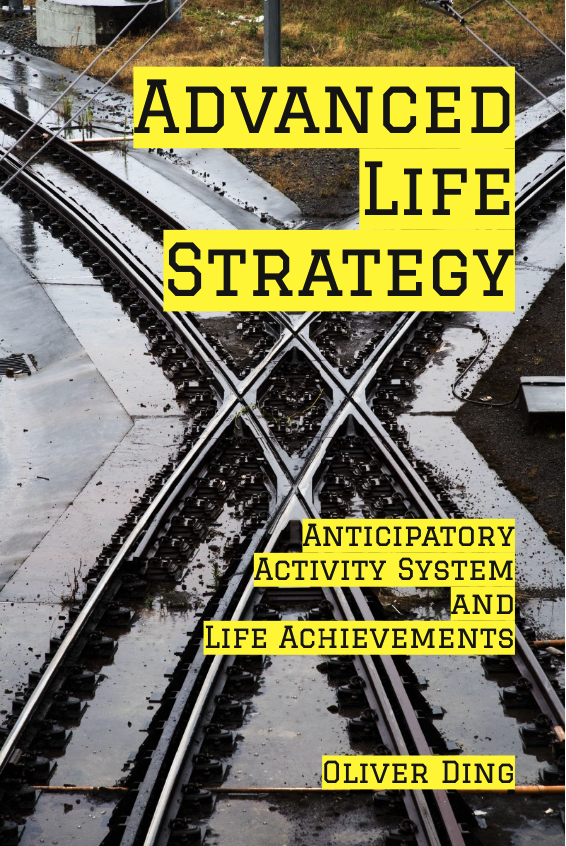
A Possible Book for Knowledge Creators
- 5 parts
- 29 chapters
- 60 articles
- Total 845 min read
- Total 223,925 words (about 448 single-spaced pages)
In 2019, I found CALL (Creative Action Learning Lab) as a personal studio for my independent knowledge discovery. From Oct 2020 to Oct 2021. I run CALL as a knowledge curation studio that produced a set of knowledge frameworks and built an ecology of ideas.
The primary theme of CALL is Creative Action. Originally, it referred to my approach to creativity research: the “Process as Product” approach. You can find more details in The NICE Way and Creative Actions.
Later, it led to the Path of Creative Life and a series of possible books: Aspects of Creative Life. See the diagram below.
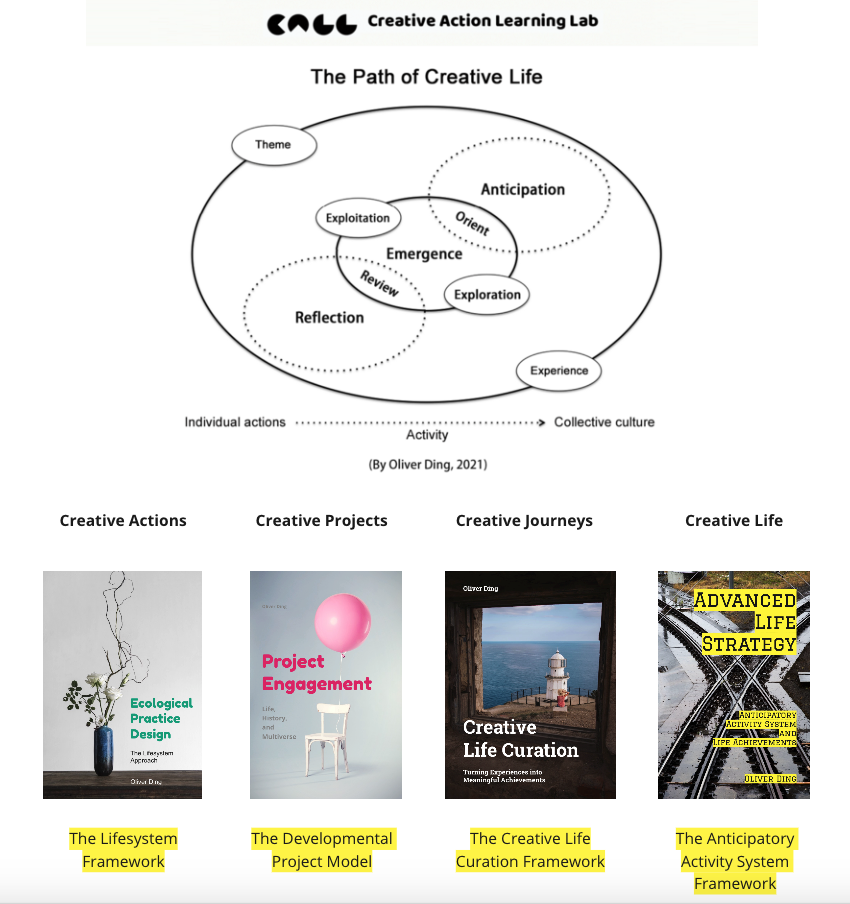
In the past 12 months, I developed a new structure of units of analysis:
1. Creative Actions
2. Creative Projects
3. Creative Journey
4. Creative Life
I also mentioned these four units of analysis in the following possible books:
1. Ecological Practice Design > Creative Actions
2. Project Engagement > Creative Projects
3. Creative Life Curation > Creative Journeys
4. Advanced Life Strategy > Creative Life
Each book also introduces a theoretical framework.
1. Ecological Practice Design > The Lifesystem Framework
2. Project Engagement > The Developmental Project Model
3. Creative Life Curation > The Creative Life Curation Framework
4. Advanced Life Strategy > The Anticipatory Activity Framework
These four books are developed for different purposes. Now I curate them together as a new meaningful whole!
This article introduces Advanced Life Strategy: Anticipatory Activity System and Life Achievements.
Contents
1. A Book for Knowledge Creators
2. The Structure of Creative Life Strategy
3. Ontology: The World of Activity
4. Realism: The Anticipatory Activity System (AAS) framework
5. Hermeneutics: Advanced Predictive Models and Strategic Curation
6. A Possible Book
7. Part One: Creative Life
8. Part Two: The World of Activity
9. Part Three: Anticipatory Activity System
10. Part Four: Second-order Activity
11. Part Five: Predictive Models
1. A Book for Knowledge Creators
My primary interest is located in the intersection between Knowledge, Creativity, and Adult Development. I roughly use Creative Life to name this focus. It’s clear that I don’t want to develop a general framework about adult development for everyone. I only consider Knowledge Workers and Creators as my target audience.
The Life Strategy Project aims to develop a systematic approach to life strategy for knowledge creators. The concept map below is the summary of the approach.
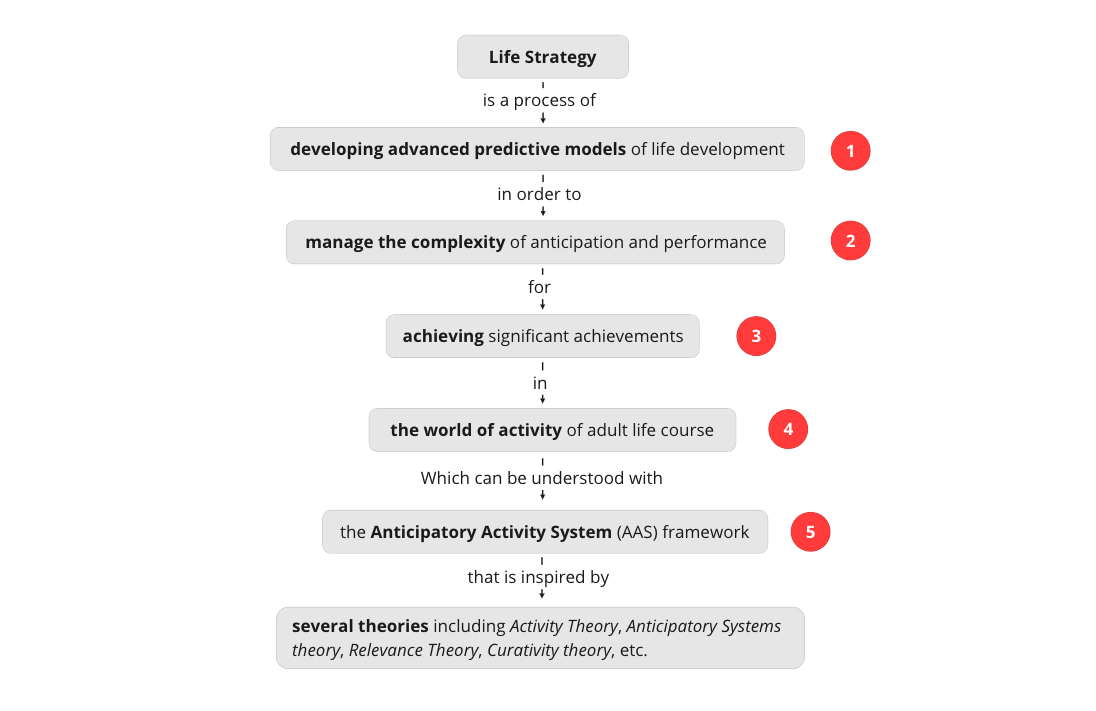
I use the above concept map to develop the systematic approach and organize the content of Advanced Life Strategy.
The Life Strategy Project is inspired by Alfred Schutz, James G. March, and David McClelland. See the concept map below.
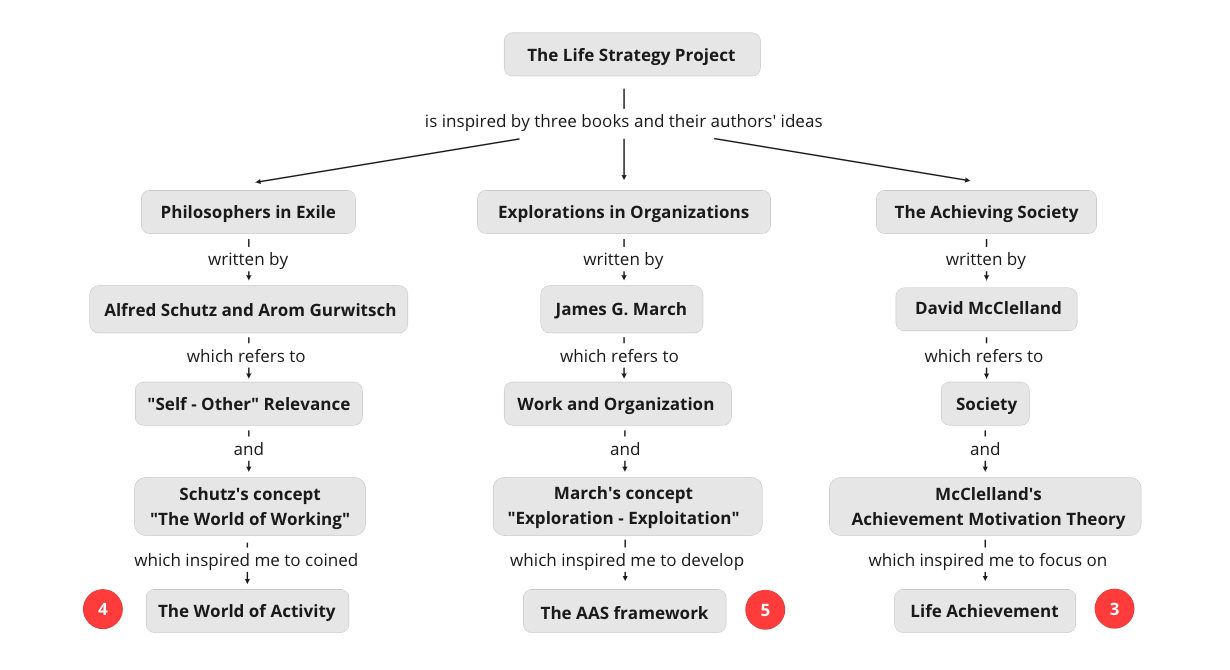
Alfred Schutz is an Austrian philosopher and social phenomenologist. His career is a perfect example of Creative Life.
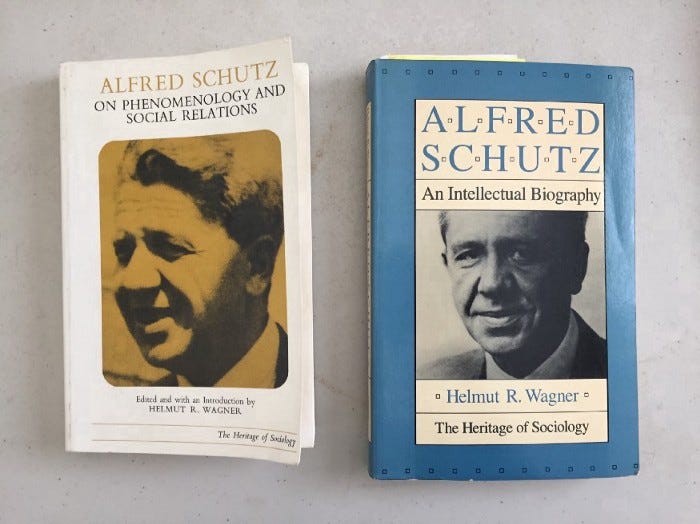
Schutz is a creative theorist whose work applied phenomenology to sociology. His works are recognized as creative projects. However, his life can be considered a creative life too. Though Schutz had a very short teaching career at the Graduate Faculty of the New School for Social Research, he was not a formal scholar who had a job in a research university during most of his intellectual career. We can say that he was an extremely excellent independent researcher.
According to Helmut R. Wagner who is the author of Alfred Schutz: An Intellectual Biography, “In organizing his time, Schutz gave priority to four sets of relevant interests. Each of them belonged to a different area of concern, each had its own primary relevance, and each formed a relatively self-contained sphere of life. ” Schutz’s four life spheres are family life, business activities, theoretical-philosophical activities, and music.
Schutz’s life is a creative life of intellectuals. I’d like to point out that there are many kinds of creative lives. For example, Steve Jobs, Neil Alden Armstrong, Martin Luther King, and Malala Yousafzai. Moreover, we should notice that there are many creative lives that are not “Big-C” such as famous figures. Scholars have offered us a 4C model of creativity.
- Big-C: famous creative achievements such as music, paints, inventions, theories, etc.
- little-c: creative behavior in everyday life. For example, making waffle art, using cardboard boxes for sliding, decorating a place for a birthday party, etc.
- Mini-c: the novel and personally meaningful interpretation of experience, actions, and events.
- Pro-c: “amateur” creators and professional creators who are successful, but have not reached a level of prominence as eminent creators achieved.
The Life Strategy project aims to build a bridge between Pro-c and Big-C.
2. The Structure of Creative Life Strategy
There is a “Past — Present — Future” structure behind Creative Life Strategy.

The diagram was based on my diagram about The Path of Creative Life and Ping-keung Lui’s theoretical sociology, especially the notion of the fleeting moment.
In 2007, Lui published a book titled Gaze, Action, and the Social World in which he presented his account of theoretical sociology. The fundamental starting point of his approach is an Ontology of action, which was inspired by Saint Augustine (354–430), Martin Heidegger (1889–1976), and Maurice Merleau-Ponty (1908–1961). See the statement below:
The body is in action, action is in the fleeting moment, the fleeting moment is in the body.
According to Lui, “This moment is Augustinian, it comprises at the same time the Present of the Past, the Present of the Present, and the Present of the Future. The actor Remembers in the present of the past, Pays Attention in the present of the present, Expects in the present of the future.” (p.235–236, 2010, The Scientific Project of Sociology)
There is a connection between the Path of Creative Life and Lui’s ontology of action.
- Reflection: Remembers in the present of the past
- Emergence: Pays Attention in the present of the present
- Anticipation: Expects in the present of the future
The connection encouraged me to adopt Lui’s theoretical sociology as a reference frame for the Creative Life Curation project and the Life Strategy project. You can find more details in Three Paths of Creative Life and A Semiotic System and A Semiotic System Diagram for Creative Life Curation.

The above semiotic system uses "ontology - realism - hermeneutics" as a reference frame to curate four frameworks.

I use the same structure to curate four ideas for the new possible book: Advanced Life Strategy.
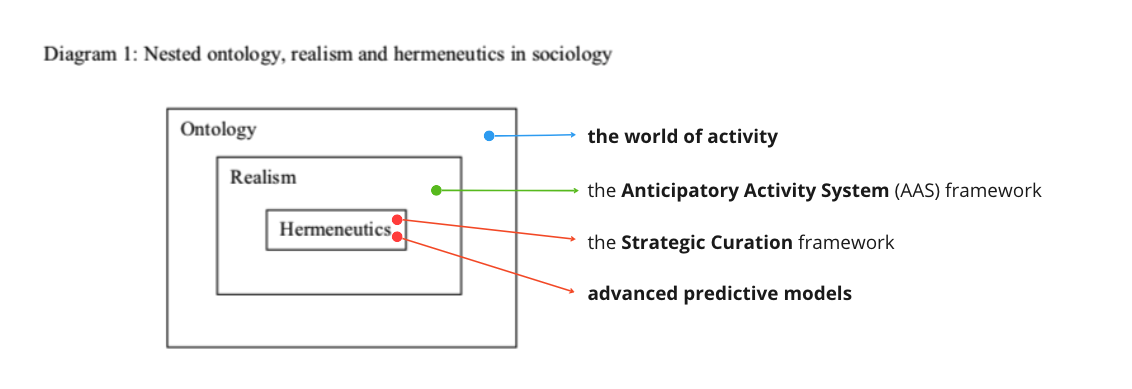
The above diagram shows four ideas of the approach for Advanced Life Strategy.
- Ontology: The World of Activity
- Realism: The Anticipatory Activity System (AAS) framework
- Hermeneutics: The Strategic Curation framework and Advanced Predictive Models
3. Ontology: The World of Activity
The notion of "the World of Activity" is inspired by Alfred Schutz's concept of "the World of Working". The World of Working is one sub-world of the World of Daily Life or the Life-world. There are other sub-worlds in the Life-world. For example, the worlds of fantasy and dream.
The difference between “the World of Activity” and “the World of Working” is the former doesn't require the distinction between the worlds of fantasy and dream and the world of working.
In order to research creative life, I think it is important to consider the worlds of fantasy and dreams since they are significant sources of creative inspiration. Since Schutz is a social scientist, the quasi-We relation of the dream is empty and ghostly, so the world of dreams is not useful for studying the We relation. However, the world of dreams is important to creative cognition which is related to creative work study.

The above diagram highlights four keywords: Birth, Death, Heaven, and Earth.
The Horizontal group refers to the "Activity" of Life while The Vertical group refers to the “Theory” of Life.
- The "Activity" of Life = the Situations of Activity of “Engagement”
- The "Theory" of Life = the Degrees of Abstraction of “Knowledge”
If we put them together, we get the following formula.
The World of Activity = The "Activity" of Life + The "Theory" of Life
You can find more details in Lifescope: The World of Activity for Creative Life Curation.
The World of Activity defines the life scope of a creative person's life. It also defines the context of Advanced Life Strategy. Especially, Life Achievement. See the concept map below.
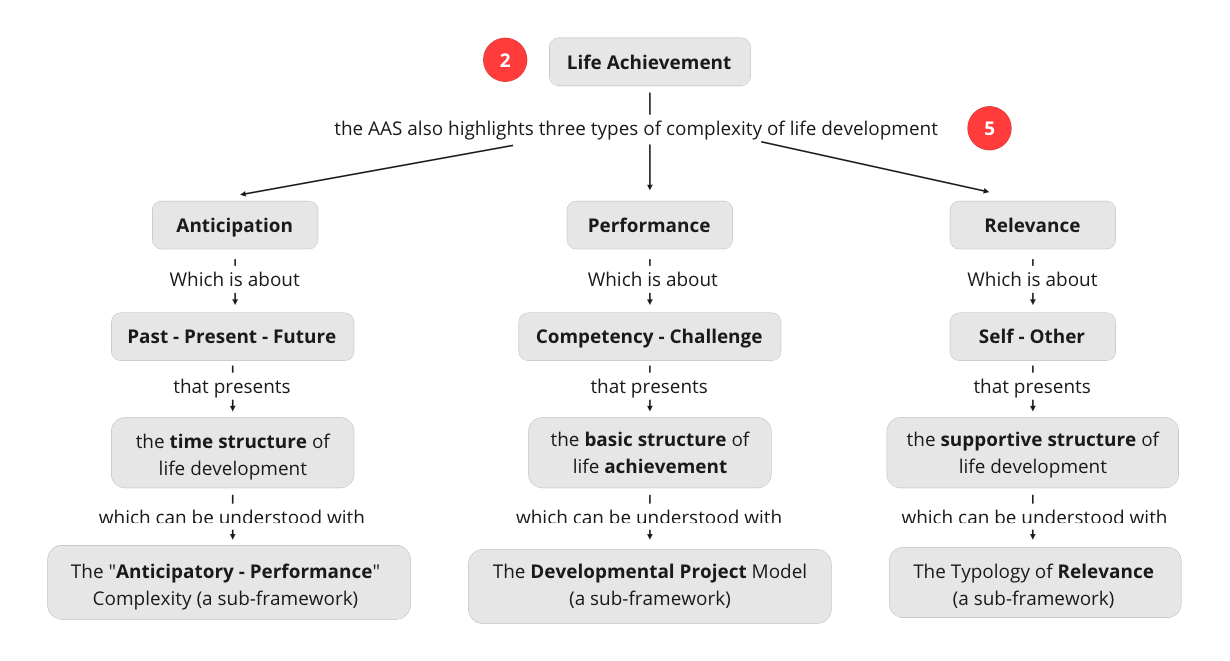
In order to understand the above three types of complexities of life achievement, we need to move to the Realism part to know more details about the Anticipatory Activity System (AAS) framework.
4. Realism: The Anticipatory Activity System (AAS) framework
The Anticipatory Activity System (AAS) framework is inspired by Activity Theory, Anticipatory System theory, Relevance theory, and other theoretical resources. The framework is about modeling a specific structure: "Self, Other, Present, Future".
An Anticipatory Activity System is formed by two parts: First-order Activity and Second-order Activity.

The core of the AAS framework is the Transactional Anticipatory System which considers the “Self, Other, Present, Future” situation. See the diagram below:
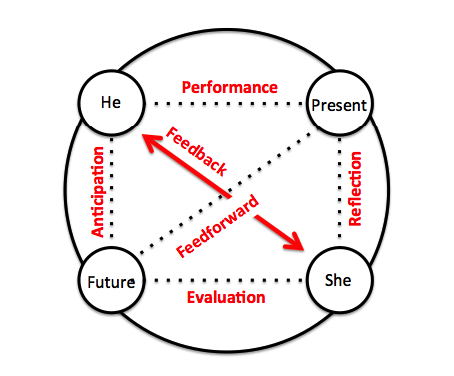
You can find more details in The iART Framework and The “Relevance” Thematic Space.
The AAS framework is an abstract model which highlights five movements of Anticipatory Activity System.
- Unfolding
- Discovering
- Modeling
- Producing
- Storytelling / Evaluating

You can find more details in Anticipatory Activity System (AAS) and A Possible Book and The AAS framework for Life Strategy and Service Knowledge Management.
From the perspective of AAS, there are two types of activities in the World of Activity:
- First-order Activity: Life Performance Activity
- Second-order Activity: Life Discovery Activity
See the concept map below.
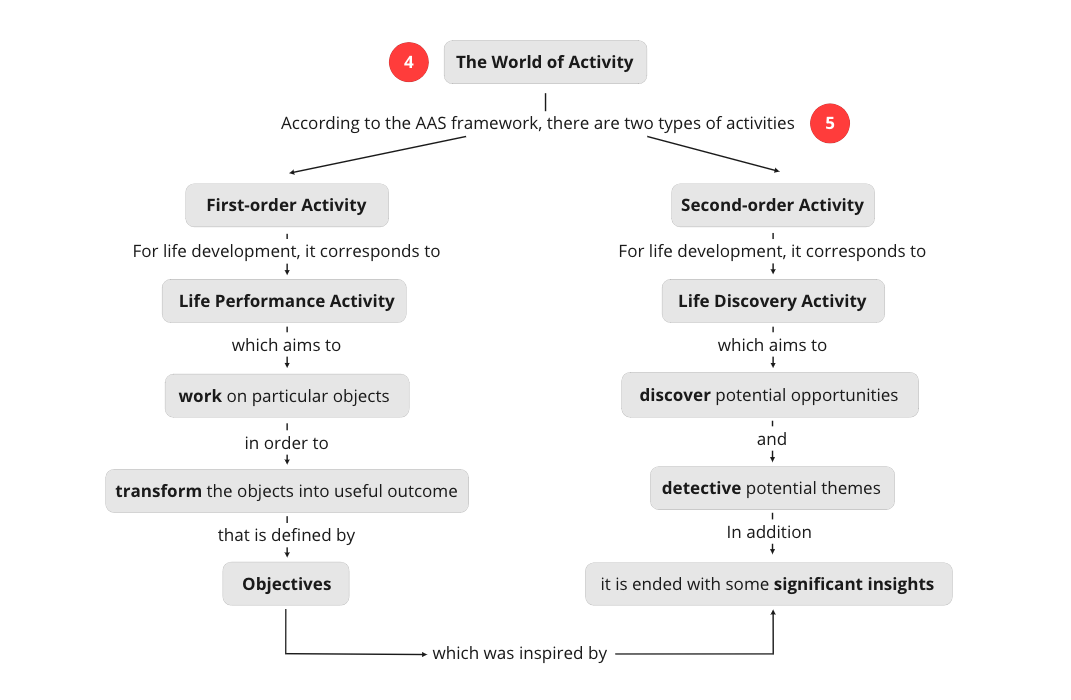
The Modeling movement refers to Predictive Model which connects to the Hermeneutics part.
5. Hermeneutics: Advanced Predictive Models and Strategic Curation
According to Robert Rosen, the Anticipatory System theory's creator, “An anticipatory system is a natural system that contains an internal predictive model of itself and of its environment, which allows it to change state at an instant in accord with the model’s predictions pertaining to a later instant.” In contrast, a reactive system only reacts, in the present, to changes that have already occurred in the causal chain, while an anticipatory system’s present behavior involves aspects of the past, present, and future.
The core idea is the “internal predictive model” and the model can predict the Self and the Environment.
What do predictive models look like?
Robert Rosen’s theory is a general theory. Since my framework also considers Activity Theory and other theoretical resources, I have to develop my own ideas of Predictive Models.
I made a distinction between General Predictive Model and Particular Predictive Models for the Life Strategy project.
The General Predictive Model refers to a person’s mind and knowledge.
For a particular project, a person will develop a particular model to help her model the development of the project. In other words, she will use a model to predict the future of the project.
The model can be explicit, such as a diagram with a document. However, the model can be tacit, the person just uses her mind without any instruments to display the model.
What I found from my empirical research is that sometimes the person would like to visualize or write her model about the project because this way is a great way of thinking. But the person would like to keep the model as private information unless the project needs the public version of the model for storytelling.
The model is the outcome of the “objective—subjective” knowledge curation. For example, a friend of mine adopts some psychological knowledge and the OKR method to build a model and use the model to develop her life development program. She modified her model several times in order to match the change of her clients.

Following the distinction between the General Predictive Model and Particular Predictive Models, we can define two types of Strategic Curation Activity.
- Type 1: It is about curating strategy-related concepts and knowledge. It aims to reflect on the General Predictive Model. In other words, it is about reflecting on our minds, behaviors, and knowledge.
- Type 2: It is about curating situational information around a particular project and developing strategic responses. It aims to create a new Particular Predictive Model and reflect on an old Particular Predictive Model.
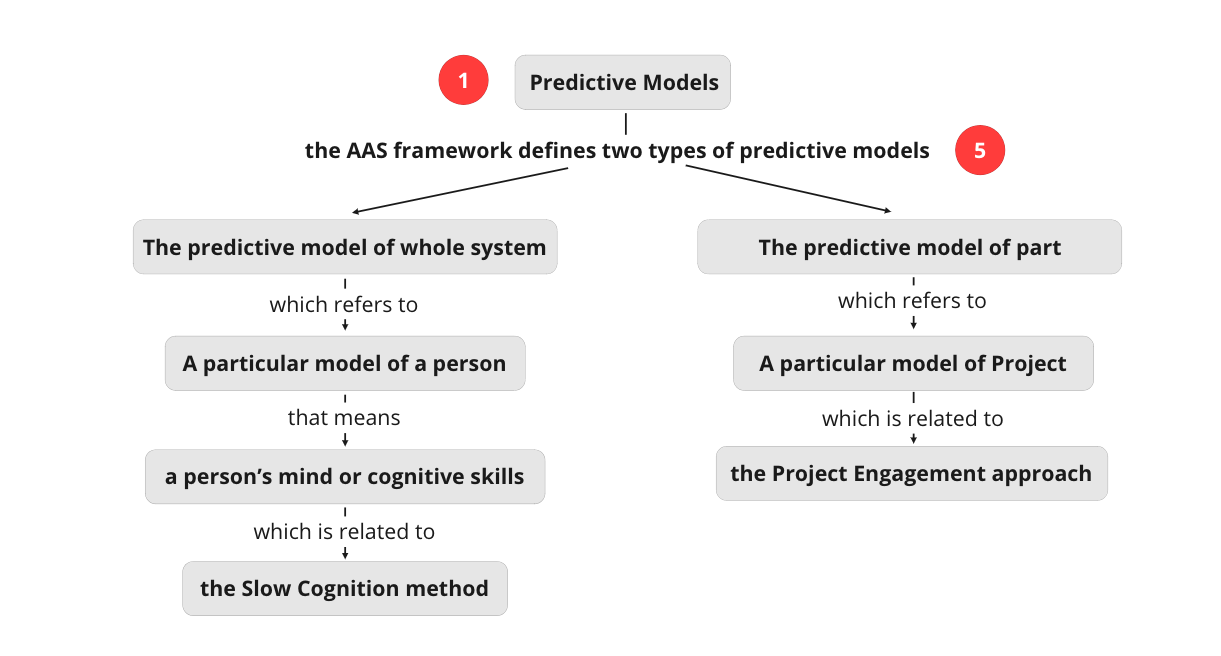
Based on the fleeting moment and Curativity Theory, I developed a five-space model for strategic curation.

The Strategic Curation Model is a five-space model.
- Experience Space: It refers to the facts of the Past.
- Challenge Space: It refers to the problems in the Present
- Response Space: It refers to the solutions for the Future
- Reference Space: It refers to reliable and validated knowledge for thinking
- Speculative Space: It refers to imaginative thinking such as Counterfactual Thinking about the Past and Prefactual Thinking about the Future.
What does Strategic Curation mean?
It refers to using a specific strategy to curate pieces of experience, knowledge, and resources into a meaningful whole for a better future.
You can find more details in A Five-space Model for Strategic Curation Activity.
The concept map below shows more details of applying the Five-space model to develop advanced predictive models.
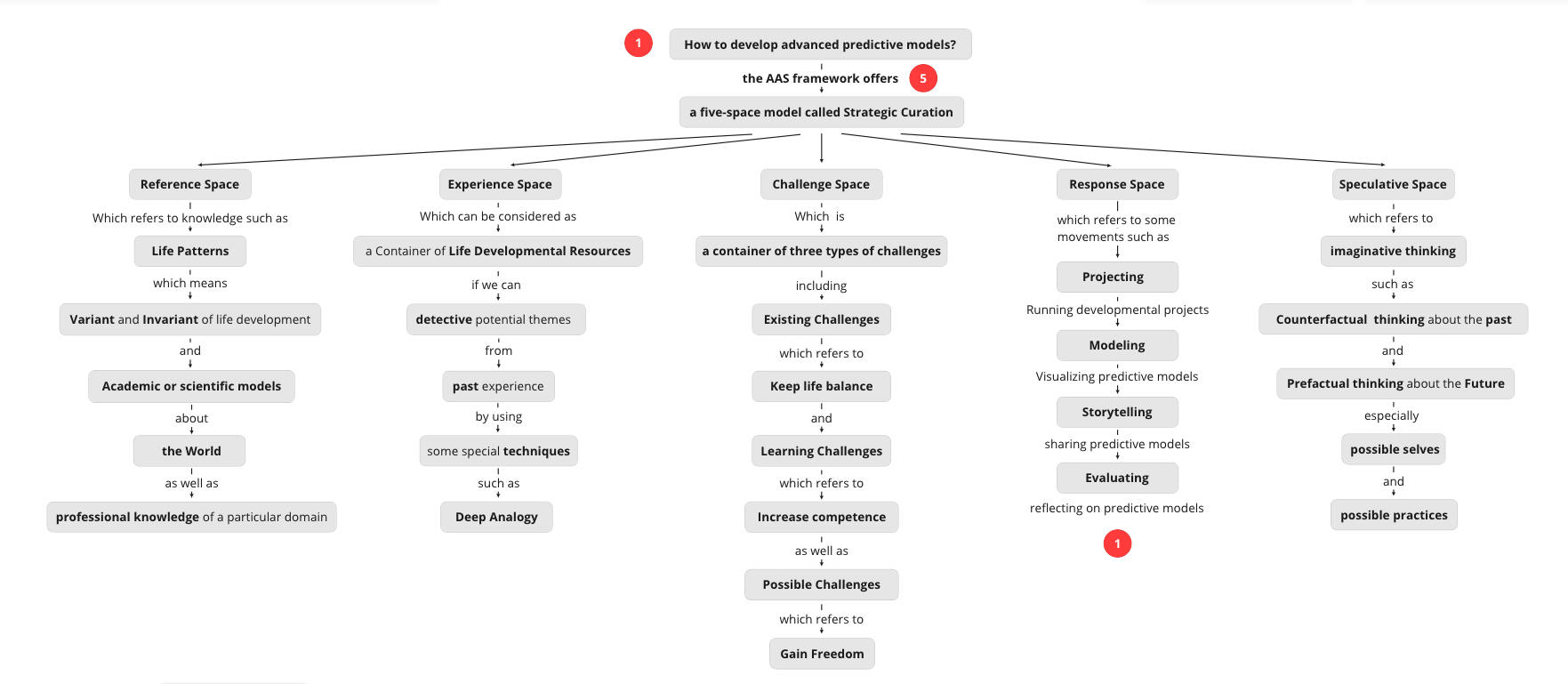
6. A Possible Book
On August 26, 2022, I reviewed the historical development of the Anticipatory Activity System (AAS) framework. See the diagram below.

In the past four months, I took the ten move which is located at "Meta-theory". The outcome is a new systematic approach to life strategy for knowledge creators.
The above discussion presents the approach with diagrams and concept maps for knowledge creators.
I also wrote many articles about the Anticipatory Activity System (AAS) framework and the new approach to life strategy.
Now it's time to edit a new possible book and close the Life Strategy project (phase I).

I will collect my articles about Life Strategy, Life Discovery, and the Anticipatory Activity System framework. Also, I will make a Table of Contents (TOC) for the new possible books.
The TOC and the collection of articles will be the prototype of the new possible book.
7. Part One: Creative Life
Part One collects my articles about Creative Life and offers a background of the Life Strategy project.
Chapter 1: Life-to-be-Owned
(36 min read, Oct 27, 2021 - Original article)
This article mentions the story of Jobs-to-be-Done and offers a new framework called Life-to-be-Owned. You can find many themes in the article.
- Creators v.s. Customers
- Jobs v.s. Life
- Motivation and Activity
- Knowledge Frameworks
- Concept Competition
- Career Development
- Knowledge Innovation
These themes are also essential to understanding creative life, especially knowledge creators.
Chapter 2: HERO U — A New Framework for Knowledge Heroes
(17 min read, June 26, 2020 - Original article)
This article introduces a concept called Knowledge Heroes and provides Knowledge Heroes a framework for closing the gap between “Theory” and “Practice”.
The HERO U framework is my journey of making tools for knowledge creators who want to make unique epistemic impacts. It guided me to run the Activity U project and work on Activity Theory.
Chapter 3: Life as Activity (version 0.3)
(37 min read, Nov 29, 2020 - Original article)
The Life-as-Activity approach is a by-product of Activity U. The Activity U project is a case study for “HERO U” which is a framework for closing the gap between theory and practice.
The approach is based on the Activity System model and the notion of Temporal Activity Chains. This is the seed of my journey of creating the Anticipatory Activity System framework.
Chapter 4: Mapping the "Life" thematic space
(35 min read, Feb 17, 2022 - Original article)
This article used a unique method called Mapping Thematic Space to review my thoughts about the theme of "Life".
This is the first step to defining the concept of "Life Strategy" by using the thematic dialogue technique.
Chapter 5: Mapping the "Strategy" thematic space
(23 min read, Feb 3, 2022 - Original article)
This article used a unique method called Mapping Thematic Space to review my thoughts about the theme of "Strategy".
This is the second step to defining the concept of "Life Strategy" by using the thematic dialogue technique.
Chapter 6: The Path of Creative Life
(11 min read, Aug 30, 2021 - Original article)
This article introduces the diagram of "the Path of Creative Life" which is the foundation of the systematic approach to life strategy.
8. Part Two: The World of Activity
Part One collects my articles about Creative Life and offers a background of the Life Strategy project.
Chapter 7: Curativity Theory for Personal Innovation
(8 min read, Nov 4, 2021 - Original article)
This article reviewed a failed project about writing a possible book titled Career Curation: Curativity Theory for Personal Innovation.
During working on this project, I found the Austrian philosopher and social phenomenologist Alfred Schutz’s ideas and his career are perfect for the Career Curation project.
Later, I adopted his Relevance Theory for my projects and used “the World of Working" to develop the notion of "the World of Activity".
Chapter 8: The World of Activity as Creative Lifescope
(14 min read, Nov 18, 2022 - Original article)
The notion of "the World of Activity" is a new definition of "Lifescope". It also proposes a new theoretical approach to rethinking Activity Theory.
The new notion is inspired by "the World of Working" and it also emphasizes the perspective of subjective experience, we can consider it to be a creative thematic dialogue between Phenomenology and Activity Theory.
Chapter 9: Units of Analysis
(3 min read, Nov 2, 2022 - Original article)
The original article is titled Aspects of Creative Life: Four Possible Books for Knowledge Creators.
In the past 16 months, I developed a new structure of units of analysis for the Life Strategy project.
1. Creative Actions
2. Creative Projects
3. Creative Journey
4. Creative Life
We can use these units of analysis to understand the World of Activity. You can find more details in the following articles.
- Creative Actions: The NICE Way and Creative Actions (41 min read)
- Creative Projects: The Developmental Project Model (12 min read)
- Creative Journey: The “Possible Journey” (9 min read)
- Creative Life: How to Grow A Knowledge Enterprise? (16 min read)
I also use these units of analysis for the Creative Life Curation framework, you can find more details in Creative Life Curation: Turning Experiences into Meaningful Achievements.
Chapter 10: Kinds of Actors
(12 min read, Nov 21, 2022 - Original article)
The original article was written for the Creative Life Curation framework. It made a distinction between Creators and Curators.
This notion is inspired by sociologists' distinction between Actors and Researchers. While Actors don't need to consider producing scientific sociological knowledge, researchers have to do it.
For the life strategy project, we can make a similar distinction between Creators and Strategists.
9. Part Three: Anticipatory Activity System
Part three collects articles about the Anticipatory Activity System (AAS) framework.
Chapter 11: The AAS Framework
(9 min read, May 20, 2022 - Original article)
This is a short introduction to the Anticipatory Activity System (AAS) framework.
Chapter 12: The iART Framework
(12 min read, Aug 21, 2021 - Original article)
The core of the AAS framework is the iART framework which is about "Self, Other, Present, and Future".
Chapter 13: Strategy as Anticipatory Activity System
(12 min read, Sep 15, 2021 - Original article)
This article develops the abstract model of Anticipatory Activity System and connected it with Strategy. This is the foundation of the AAS framework.
Chapter 14: The "Self-Other" Relevance
(18 min read, Feb 15, 2022 - Original article)
The original article was titled Mapping Thematic Space #5: The “Relevance” Thematic Space.
In this article, you can find an important sub-framework of the AAS framework: the "Self-Other" Relevance.
You can see a related concept of "Unfoldness" in the following article:
- The Unfoldness of Activity (9 min read, May 10, 2022)
Chapter 15: The “Present — Future” Fit
(21 min read, Feb 20, 2022 - Original article)
This article discussed the "Present - Future" Fit which is a pair of concepts of the AAS framework. It also introduced the ECHO Way as a practical tool for dealing with the challenge.
Chapter 16: The “Object—Objective” Gap
(17 min read, Feb 22, 2022 - Original article)
This article discussed the "Object - Objective" Gap which is an important issue of the AAS framework.
Chapter 17: The “Result — Reward” Gap
(11 min read, Feb 18, 2022 - Original article)
This article discussed the "Result - Reward" Gap which is an important issue of the AAS framework too.
Chapter 18: The “Problem—Solution” Challenge
(17 min read, Feb 24, 2022 - Original article)
This article discussed the “Problem—Solution” Challenge and Response.
Chapter 19: The Development of AAS
(17 min read, Aug 28, 2022 - Original article)
This article reviewed the historical development of the Anticipatory Activity System (AAS) framework from August 21, 2021, to August 26, 2022.
10. Part Four: Second-order Activity
For the life strategy project, Second-order Activity means Life Discovery Activities. Part Four collects articles about the concepts of "Second-order Activity" and the following three real Life Discovery Projects.
- Shaper & Supporter Lab: I am a researcher.
- The #AAS4lt program: I am a coach and a service designer.
- The Slow Cognition Project (Phase I): I am a creator.
Originally, the iART framework which is the core of the AAS framework was born from an empirical research project about an adult development program: Shaper & Supporter Lab (code name).
A friend of mine started her journey of life discovery in Feb 2021. Later, she found Shaper & Supporter Lab and started offering life discovery and other life development services for others in April 2021.
I also hosted an 8-step 1:1 life coaching program called #AAS4LT from March 2022 to June 2022.
In addition, I interviewed several people about their journeys of life discovery and life transitions.
Part Four contained some articles about my empirical research activities about Life Discovery Activity.
Chapter 20: A Typology for Anticipatory Activity System
(9 min read, Nov 4, 2022 - Original article)
A primary pair of concepts of AAS are First-order Activity and Second-order Activity. While First-order Activity refers to goal-directed Activity, Second-order Activity refers to discovering a goal for First-order Activity.
In this article, I developed a new typology of Activity and offered more details about Second-order Activity.
Chapter 21: A Typology of First-order Activity
(25 min read, Sep 12, 2020 - Original article)
This article introduced a typology of Activity from the perspective of traditional activity theory. The typology was developed by activity theorist Clay Spinuzzi in 2015.
I also shared my own experience of using the typology for a strategic discussion about Andmind Group in 2017.
Chapter 22: The Hiddenness of Second-order Activity
This chapter is a case study about Second-order Activity. It contains the following two articles:
- Oliver Ding @ 2021 and Second-order Activity (13 min read)
- The “Tacit” Type of Second-order Activity (8 min read)
From my empirical research, I discovered three types of Second-order Activity:
- Artificial (Explicit Second-order Activity)
- Natural (Explicit Second-order Activity)
- Tacit Second-order Activity
Chapter 23: The #AAS4LT Program
This chapter is a collection of articles about the Anticipatory Activity System for Life Transitions program (#AAS4LT).
Based on the AAS framework, the program was developed with an 8-step practical framework. I also hosted the program on Milanote which is a digital whiteboard platform from March 2022 to June 2022.
You can find more details in the following articles.
- Anticipatory Activity System for Life Transitions (7 min, Mar 22, 2022)
- Modeling A Developmental Project (8 min, Mar 28, 2022)
- The Life Discovery Board - public, v2 (3 min, June 30, 2022)
Chapter 24: The Life Discovery Project
This chapter features three articles about the Life Discovery project.
From Jan 2022 to June 2022, I applied the Life-as-Project approach to Life Discovery Activity and developed a series of tools such as a toolkit, a canvas, and several models and frameworks.
I also joined the following three Life Discovery Projects:
- Shaper & Supporter Lab: I am a researcher.
- The AAS Board: I am a coach and a service designer.
- The Slow Cognition Project (Phase I): I am a creator.
This journey was documented in many articles I wrote on Medium. The following three articles reflected on the journey.
- Life Discovery: Biography, Journey, Program (Part 1) - 16 min read
- Life Discovery: Biography, Journey, Program (Part 2) - 11 min read
- Life Discovery: Biography, Journey, Program (Part 3) - 11 min read
- Twelve Significant Insights from Four Months - 31 min, Apr 25, 2022
- “Points of Observation” and “Significant Insights” - 8 min, Apr 27, 2022
- Life Discovery: Significant Insights Analysis - 6 min, Apr 29, 2022
Chapter 25: Knowledge, Domain, and City
This chapter features three articles about other types of Second-order Activity.
- Knowledge Discovery
- Domain Discovery
- City Discovery
You can find some tools about these second-order activities in the following articles.
- Three Canvases for Personal Life Reflection (4 min read, Nov 1, 2022)
- Knowledge Discovery (Book) - (14 min read, May 19, 2022)
- The Domain Discovery Activity (12 min read, June 13, 2022)
- City as Developmental Platform (8 min read, Oct 22, 2022)
11. Part Five: Predictive Models
As mentioned above, the concept of "Predictive Models" is the core idea of Robert Rosen's Anticipatory Systems theory.
Robert Rosen’s theory is a general theory. Since my framework also considers Activity Theory and other theoretical resources, I have to develop my own ideas of Predictive Models.
I made a distinction between General Predictive Model and Particular Predictive Models for the Life Strategy project.
The General Predictive Model refers to a person’s mind and knowledge.
For a particular project, a person will develop a particular model to help her model the development of the project. In other words, she will use a model to predict the future of the project.
I also developed a five-space model called Strategic Curation for building Predictive Models.
Chapter 26: The Strategic Curation Model
This Chapter collects a series of articles about the Strategic Curation Model.
- An Introduction to Strategic Curation Model (7 min, Dec 13, 2022)
- A Five-space Model for Strategic Curation (14 min, Nov 17, 2022)
- Three Meta-knowledge of Strategic Curation (8 min, Dec 5, 2022)
- Turning Potential Knowledge into Actual Knowledge (9 min, Dec 7, 2022)
- Conceptual Change and Developmental Resources (13 min, Dec 7, 2022)
- Taking Opportunities and Long-term Response (19 min, Dec 11, 2022)
- Ecological Strategic Cognition (8 min, Dec 8, 2022)
Chapter 27: The “Anticipation — Performance” Complexity
This Chapter collects several articles about the Predictive Model and Anticipatory Activity System. Especially a tool called Anticipation - Performance" Complexity.
- The Predictive Model and Anticipatory Activity System (8 min, May 30, 2022)
- The iART Diagram Network (11 min, Aug 31, 2021)
- The Defining Zone (13 min, Sep 3, 2021)
- iART Diagram Notation (12 min, Sep 1, 2021)
Chapter 28: Running A Developmental Project
The Anticipatory Activity System (AAS) framework uses the Developmental Project Model as a general model for understanding First-order Activity and Second-order Activity.
This Chapter collects several articles about the Developmental Project.
- The Life-as-Project Approach (9 min, Feb 13, 2022)
- Running A Developmental Project (9 min, June 9, 2022)
- The Developmental Project Model (12 min, Aug 18, 2022)
Chapter 29: Toward A Curated Mind
The General Predictive Model refers to a person’s mind and knowledge. This chapter collects several articles about mind, intelligence, and knowledge curation.
- The Art of Intelligence or Mind (8 min, June 16, 2022)
- How Does Collective Learning Work? (6 min, June 7, 2022)
- AAI: Cross-boundary Knowledge Curation (16 min, 2022)
- Creative Holism and Applied Knowledge Curation (24 min, 2022)
- The Curated Mind (22 min, March 15, 2022)
- The Model of Curated Mind (6 min, March 21, 2022)
